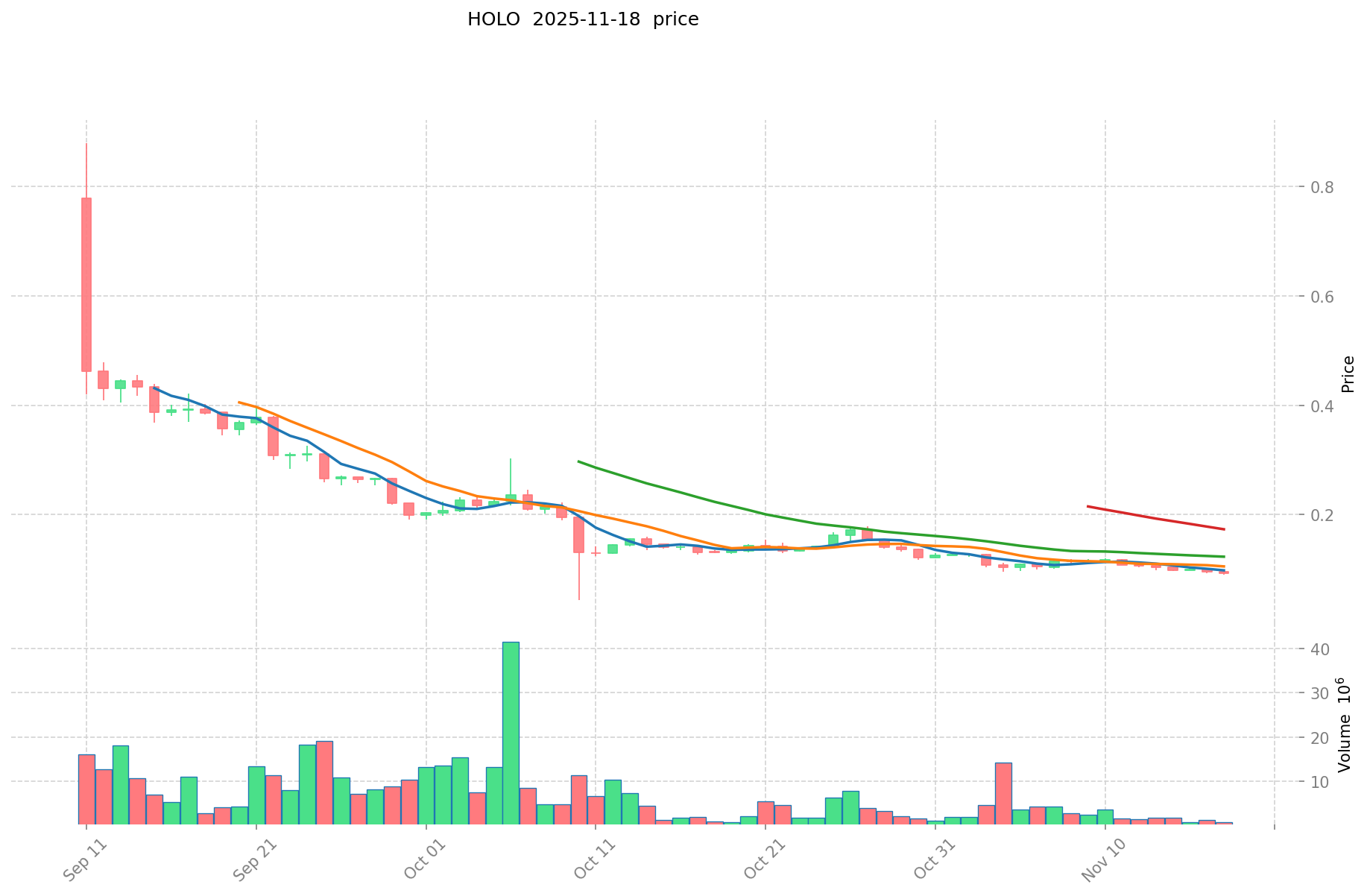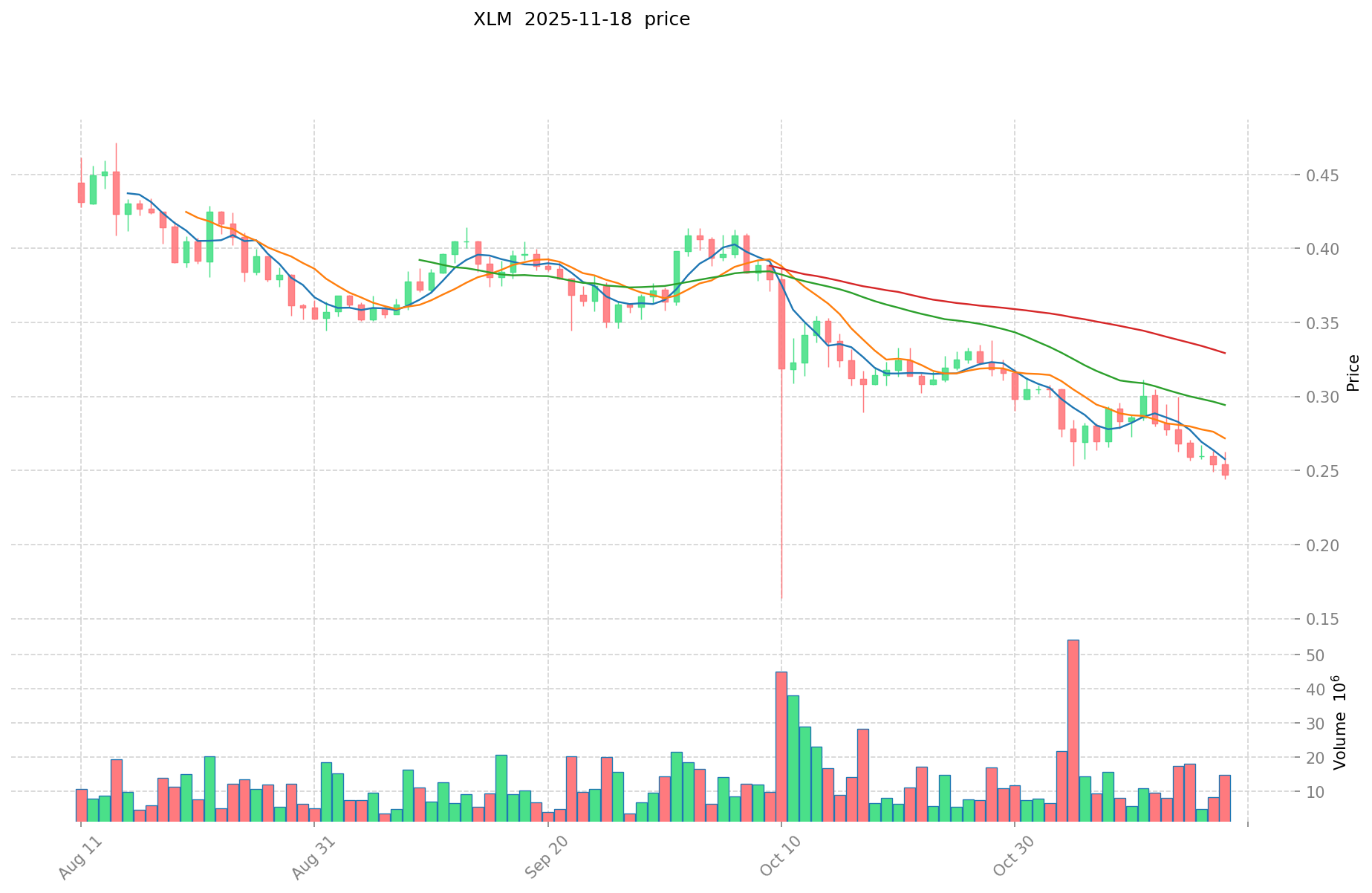HOLO vs XLM: Comparing Two Emerging Cryptocurrency Platforms for Cross-Border Transactions
Introduction: HOLO vs XLM Investment Comparison
In the cryptocurrency market, the comparison between Holoworld AI (HOLO) and Stellar (XLM) has been an unavoidable topic for investors. The two not only show significant differences in market cap ranking, application scenarios, and price performance, but also represent different positions in the crypto asset landscape.
Stellar (XLM): Since its launch in 2014, it has gained market recognition for its efficient cross-border payment capabilities.
Holoworld AI (HOLO): Established in 2022, it has been hailed as a decentralized hub for consumer AI, focusing on AI-native IPs and companies.
This article will provide a comprehensive analysis of the investment value comparison between HOLO and XLM, focusing on historical price trends, supply mechanisms, institutional adoption, technological ecosystems, and future predictions, attempting to answer the question most important to investors:
"Which is the better buy right now?"
I. Price History Comparison and Current Market Status
HOLO and XLM Historical Price Trends
- 2025: HOLO reached its all-time high of $0.88 on September 11, 2025.
- 2025: XLM experienced significant volatility, with its price ranging from $0.00047612 to $0.875563.
- Comparative analysis: In the current market cycle, HOLO dropped from its high of $0.88 to a low of $0.04289, while XLM has shown more stability, maintaining a price above $0.24.
Current Market Situation (2025-11-19)
- HOLO current price: $0.09565
- XLM current price: $0.25676
- 24-hour trading volume: HOLO $154,268 vs XLM $3,449,921
- Market Sentiment Index (Fear & Greed Index): 11 (Extreme Fear)
Click to view real-time prices:
- View HOLO current price Market Price
- View XLM current price Market Price


II. Core Factors Influencing HOLO vs XLM Investment Value
Market Sentiment Impact
- HOLO: Price directly affected by investor sentiment and confidence, particularly when news about widespread adoption emerges
- XLM: Experiences heavy volatility influenced by institutional buying and selling activities
- 📌 Historical Pattern: Market sentiment drives short-term price movements while fundamentals determine long-term value.
Institutional Activities
- Institutional Holdings: XLM shows significant institutional interest with notable volatility due to institutional selling
- Adoption Patterns: HOLO's value is tied to its use cases and partnerships in the AI and blockchain space
- Market Integration: Institutional trading volumes can trigger significant price movements, especially for XLM
Technology and Use Cases
- HOLO: Connected to AI integration with blockchain, demonstrated by events like "HOLO Genesis airdrop" launched on September 11th
- XLM: Functions primarily as a cross-border payment solution with established infrastructure
- Ecosystem Comparison: Both operate in different niches with HOLO targeting AI/Web3 integration while XLM focuses on financial transactions
External Market Factors
- Crypto Market Correlation: Both assets affected by broader crypto market trends and sentiment
- Regulatory Environment: Influenced by regulatory developments like the CFTC's oversight of spot markets
- Market Volatility: Both tokens subject to industry-wide liquidation events, with over 140,000 investors reportedly liquidated in recent market turbulence
III. 2025-2030 Price Prediction: HOLO vs XLM
Short-term Prediction (2025)
- HOLO: Conservative $0.0928 - $0.0957 | Optimistic $0.0957 - $0.1331
- XLM: Conservative $0.2234 - $0.2568 | Optimistic $0.2568 - $0.2696
Mid-term Prediction (2027)
- HOLO may enter a growth phase, with an estimated price range of $0.0989 - $0.1569
- XLM may enter a consolidation phase, with an estimated price range of $0.1506 - $0.3292
- Key drivers: Institutional capital inflow, ETF, ecosystem development
Long-term Prediction (2030)
- HOLO: Base scenario $0.1800 - $0.2448 | Optimistic scenario $0.2448 - $0.2448
- XLM: Base scenario $0.3978 - $0.4694 | Optimistic scenario $0.4694 - $0.4694
Disclaimer
HOLO:
| 年份 | 预测最高价 | 预测平均价格 | 预测最低价 | 涨跌幅 |
|---|---|---|---|---|
| 2025 | 0.1331064 | 0.09576 | 0.0928872 | 0 |
| 2026 | 0.127020852 | 0.1144332 | 0.096123888 | 19 |
| 2027 | 0.1569451338 | 0.120727026 | 0.09899616132 | 26 |
| 2028 | 0.204089037453 | 0.1388360799 | 0.102738699126 | 45 |
| 2029 | 0.18860881454415 | 0.1714625586765 | 0.15088705163532 | 79 |
| 2030 | 0.244848533790042 | 0.180035686610325 | 0.158431404217086 | 88 |
XLM:
| 年份 | 预测最高价 | 预测平均价格 | 预测最低价 | 涨跌幅 |
|---|---|---|---|---|
| 2025 | 0.269661 | 0.25682 | 0.2234334 | 0 |
| 2026 | 0.29482936 | 0.2632405 | 0.186900755 | 2 |
| 2027 | 0.3292612174 | 0.27903493 | 0.1506788622 | 8 |
| 2028 | 0.42580730318 | 0.3041480737 | 0.21290365159 | 18 |
| 2029 | 0.4306736723592 | 0.36497768844 | 0.1897883979888 | 42 |
| 2030 | 0.469434302871528 | 0.3978256803996 | 0.354064855555644 | 54 |
IV. Investment Strategy Comparison: HOLO vs XLM
Long-term vs Short-term Investment Strategy
- HOLO: Suitable for investors focused on AI integration and blockchain ecosystem potential
- XLM: Suitable for investors seeking established cross-border payment solutions and relative stability
Risk Management and Asset Allocation
- Conservative investors: HOLO: 20% vs XLM: 80%
- Aggressive investors: HOLO: 60% vs XLM: 40%
- Hedging tools: Stablecoin allocation, options, cross-currency portfolio
V. Potential Risk Comparison
Market Risk
- HOLO: High volatility due to newer market entry and AI sector fluctuations
- XLM: Susceptibility to institutional trading activities and broader crypto market trends
Technical Risk
- HOLO: Scalability, network stability in early stages of development
- XLM: Network congestion during high-volume periods, potential security vulnerabilities
Regulatory Risk
- Global regulatory policies may impact both differently, with XLM potentially facing more scrutiny in the financial sector
VI. Conclusion: Which Is the Better Buy?
📌 Investment Value Summary:
- HOLO advantages: AI integration potential, newer technology with growth prospects
- XLM advantages: Established cross-border payment solution, institutional adoption
✅ Investment Advice:
- Novice investors: Consider a smaller allocation to HOLO for growth potential, larger allocation to XLM for stability
- Experienced investors: Balanced portfolio with both assets, adjusting based on risk tolerance
- Institutional investors: XLM for established infrastructure, HOLO for potential AI sector disruption
⚠️ Risk Warning: The cryptocurrency market is highly volatile. This article does not constitute investment advice. None
VII. FAQ
Q1: What are the key differences between HOLO and XLM? A: HOLO is a newer cryptocurrency focused on AI integration with blockchain, while XLM is an established cross-border payment solution. HOLO has higher volatility and growth potential, whereas XLM offers more stability and institutional adoption.
Q2: Which cryptocurrency has shown better price performance recently? A: Based on recent data, XLM has shown more price stability, maintaining a price above $0.24. HOLO, on the other hand, has experienced significant volatility, dropping from its all-time high of $0.88 to a low of $0.04289.
Q3: How do institutional activities affect HOLO and XLM? A: XLM is more influenced by institutional buying and selling activities, leading to significant price movements. HOLO's value is more tied to its use cases and partnerships in the AI and blockchain space.
Q4: What are the long-term price predictions for HOLO and XLM? A: By 2030, HOLO is predicted to reach a base scenario of $0.1800 - $0.2448, with an optimistic scenario of up to $0.2448. XLM is predicted to reach a base scenario of $0.3978 - $0.4694, with an optimistic scenario of up to $0.4694.
Q5: How should investors allocate their portfolio between HOLO and XLM? A: Conservative investors might consider allocating 20% to HOLO and 80% to XLM, while aggressive investors might opt for 60% HOLO and 40% XLM. The allocation should be based on individual risk tolerance and investment goals.
Q6: What are the main risks associated with investing in HOLO and XLM? A: HOLO faces high volatility due to its newer market entry and AI sector fluctuations, as well as potential scalability issues. XLM is susceptible to institutional trading activities and may face regulatory scrutiny in the financial sector. Both are subject to general cryptocurrency market risks.
Share
Content